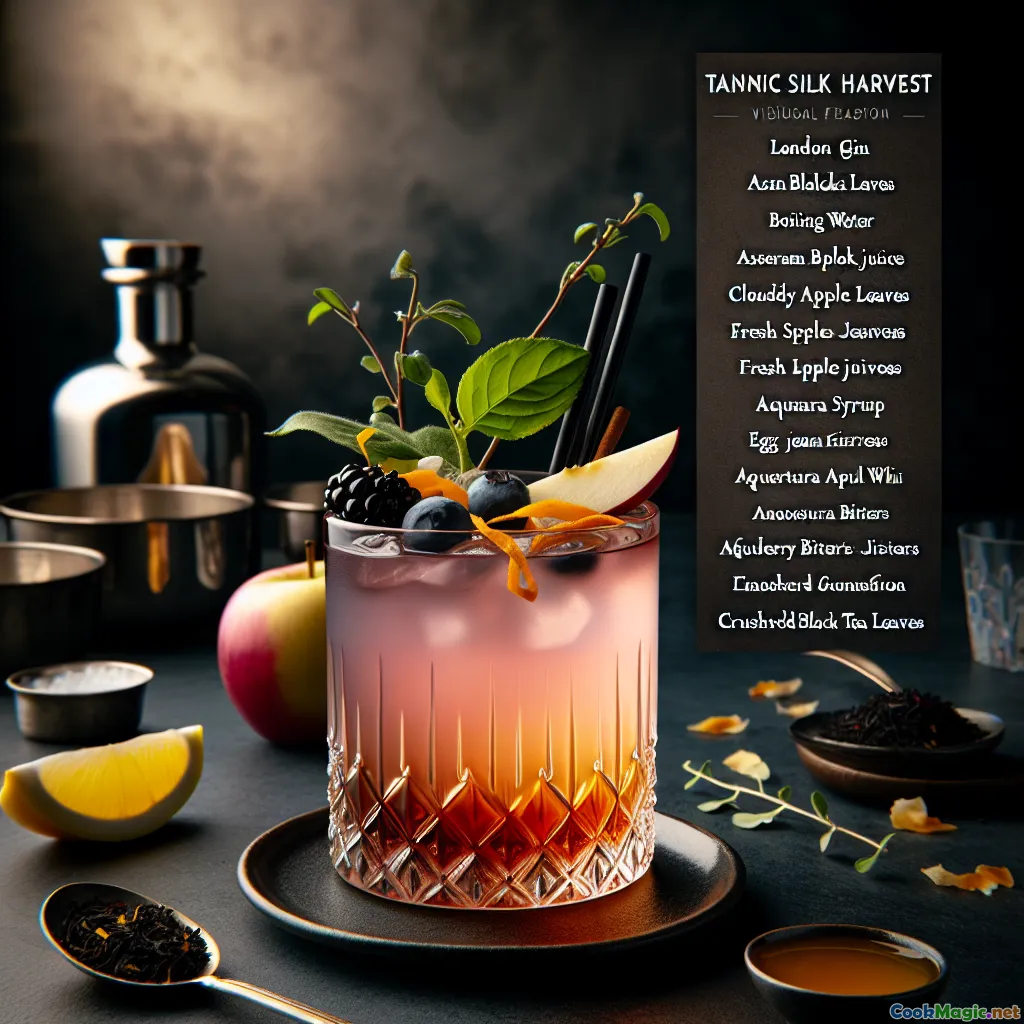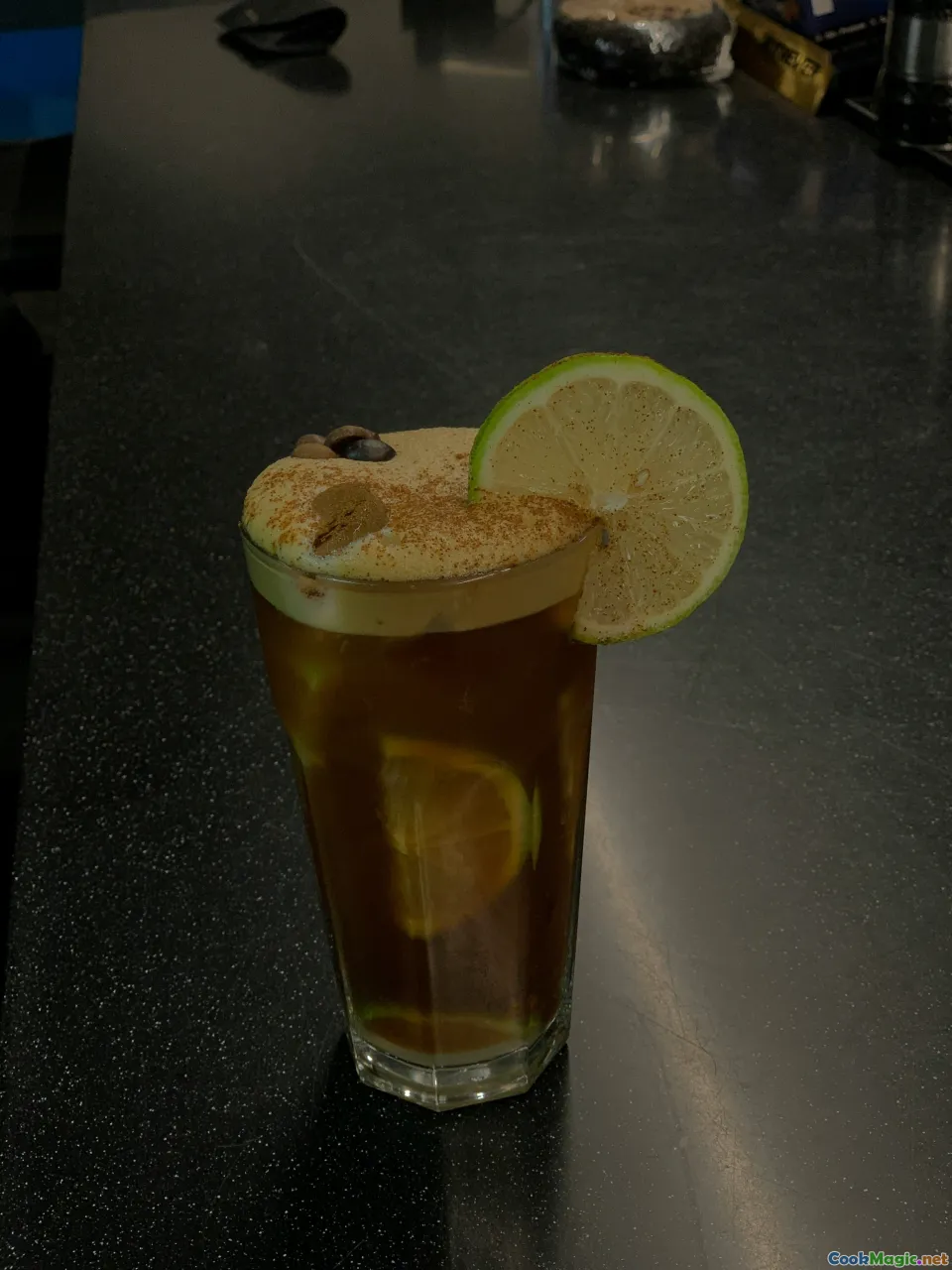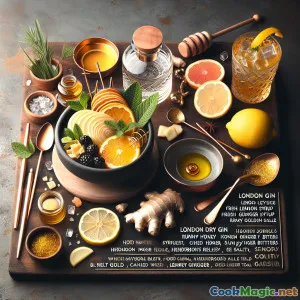
茶酸酒
(Tannic Silk Harvest Tea Sour)
(0 评论)食材
-
45 ml 伦敦干金
(Classic juniper-forward gin for structure)
-
2 tsp 阿萨姆红茶叶
(Or 1 strong tea bag; provides tannic backbone)
-
60 ml 沸水
(For brewing concentrated tea)
-
25 ml 浑浊苹果汁
(Pressed British apples preferred)
-
20 ml 新鲜柠檬汁
(Strained for a smooth texture)
-
10 ml Demerara糖浆(1:1)
(Rich sweetness complements tea and apple)
-
5 ml 黑莓果酱
(A barspoon; or 7 ml blackberry liqueur)
-
25 ml 巴氏灭菌蛋清
(For a silky foam; omit if using aquafaba)
-
30 ml Aquafaba(鹰嘴豆水)
(Vegan substitute for egg white; use instead of egg)
-
2 dashes 安哥斯图拉苦味酒
(Adds warmth and color to the foam)
-
8 cubes 冰块
(用来摇动)
-
1 piece 苹果片
(Thin fan for garnish)
-
1 strip 柠檬皮
(Expressed over the top)
-
1 pinch 碎黑茶叶
(Aromatic dusting on the foam)
(Classic juniper-forward gin for structure)
(Or 1 strong tea bag; provides tannic backbone)
(For brewing concentrated tea)
(Pressed British apples preferred)
(Strained for a smooth texture)
(Rich sweetness complements tea and apple)
(A barspoon; or 7 ml blackberry liqueur)
(For a silky foam; omit if using aquafaba)
(Vegan substitute for egg white; use instead of egg)
(Adds warmth and color to the foam)
(用来摇动)
(Thin fan for garnish)
(Expressed over the top)
(Aromatic dusting on the foam)
营养
- 份量: 1
- 每份大小: 1 coupe (180 ml)
- Calories: 180 kcal
- Carbohydrates: 0 g
- Protein: 3 g
- Fat: 0 g
- Fiber: 0.3 g
- Sugar: 14 g
- Sodium: 20 mg
- Cholesterol: 0 mg
- Calcium: 15 mg
- Iron: 0.2 mg
制作步骤
-
1 - Brew tannic tea concentrate:
Combine Assam leaves with 60 ml just-boiled water and steep 4–5 minutes for a strong, tannic brew. Strain and chill quickly over ice or in the freezer briefly.
-
2 - Chill glass and prep:
Chill a coupe. Add gin, 30 ml chilled tea concentrate, apple juice, lemon juice, demerara syrup, and blackberry preserves to a shaker. Choose egg white or aquafaba, not both; add to shaker.
-
3 - Dry shake for silk:
Seal the shaker without ice and shake vigorously 10–15 seconds to aerate proteins, creating a stable, silky foam.
-
4 - Wet shake until frosty:
Add ice and shake hard 12–15 seconds until well-chilled and the tin is frosty.
-
5 - Strain and Finish:
Double-strain into the chilled coupe. Dot foam with Angostura bitters, then drag a toothpick for a feathered pattern. Garnish with an apple fan and expressed lemon peel; dust with a pinch of crushed tea.
-
6 - Taste and Adjust:
Sip and balance: add a touch more syrup for sweetness, lemon for brightness, or tea for a firmer tannic edge. Serve immediately.
Combine Assam leaves with 60 ml just-boiled water and steep 4–5 minutes for a strong, tannic brew. Strain and chill quickly over ice or in the freezer briefly.
Chill a coupe. Add gin, 30 ml chilled tea concentrate, apple juice, lemon juice, demerara syrup, and blackberry preserves to a shaker. Choose egg white or aquafaba, not both; add to shaker.
Seal the shaker without ice and shake vigorously 10–15 seconds to aerate proteins, creating a stable, silky foam.
Add ice and shake hard 12–15 seconds until well-chilled and the tin is frosty.
Double-strain into the chilled coupe. Dot foam with Angostura bitters, then drag a toothpick for a feathered pattern. Garnish with an apple fan and expressed lemon peel; dust with a pinch of crushed tea.
Sip and balance: add a touch more syrup for sweetness, lemon for brightness, or tea for a firmer tannic edge. Serve immediately.
关于 茶酸酒 :的更多信息
The Story Behind Tannic Silk Harvest
Tannic Silk Harvest is a modern British tea sour that pairs the backbone of a robust Assam brew with the orchard brightness of apple and the soft, velvety texture of a properly shaken foam. The name nods to what makes this drink memorable: tannins that structure and lengthen the finish, a silk-like head from egg white (or aquafaba), and an autumnal harvest palette of apple and blackberry. Think of it as a love letter to British tea culture and the country’s orchard heritage, interpreted through the language of the cocktail shaker.
Flavor Profile and Balance
Assam’s tannins offer a firm, malty grip that anchors juniper-led London dry gin. Cloudy apple juice brings mellow fruit with gentle acidity, while fresh lemon juice supplies the bright top notes you expect in a sour. Demerara syrup adds caramel depth that complements both tea and apple without turning the drink cloying. A barspoon of blackberry preserves infuses hedgerow character and a faint jammy richness—a tiny flourish that makes the drink feel seasonal and comforting.
Technique Tips for Silky Perfection
- Brew strong tea: You want concentration without bitterness. Four to five minutes is the sweet spot; oversteeping can push harsh, puckering tannins. Chill the tea quickly to avoid dilution.
- Dry shake first: Aerating the proteins from egg white (or aquafaba) before adding ice builds a tight, glossy foam. Then wet shake with ice for proper chilling and dilution.
- Double-strain: Use a Hawthorne and a fine strainer to trap blackberry seeds and tea flecks, giving a custard-smooth texture.
- Garnish with intention: Angostura bitters add spice and paint the foam with aromatic warmth; a tiny dusting of crushed tea echoes the drink’s central theme.
Ingredient Insights and Substitutions
- Gin: A classic London dry supports the tea’s structure. For softer botanicals, try an English garden-style gin; for bolder spice, a navy-strength gin can work—reduce to 40 ml.
- Tea: Assam provides the malty tannins that define the drink. For a citrusy twist, switch to Earl Grey; for a smoky edge, try a restrained measure of Keemun or Lapsang (go lightly).
- Sweetener: Demerara syrup adds molasses complexity. Honey syrup (2:1) is lovely, albeit not vegan; maple syrup can lend a foresty note.
- Foam: Pasteurized egg white is traditional; aquafaba makes a superb vegan alternative with similar foam stability. If using aquafaba, add a tiny pinch of fine salt to sharpen flavor and foam.
Make-It-Your-Own Variations
- No-ABV: Replace gin with 45 ml cold-brewed juniper-angelica tea or a nonalcoholic gin, keep the rest, and reduce syrup slightly.
- Spritzed: Top with 30–45 ml chilled dry cider for a sparkling harvest riff; build in a small wine glass over a large cube.
- Warmer: For a winter twist, serve gently warmed without egg, focusing on tea, apple, lemon, and a touch of syrup; finish with expressed lemon oils.
Serving and Pairing
Serve in a chilled coupe to showcase the foam cap. The drink pairs beautifully with sharp cheddar, oatcakes, or a slice of apple tart. Herbal and spice-forward aromas make it a natural aperitif that also plays well with roast poultry or autumn vegetable starters.
Cultural Notes
Tea is a daily ritual in the United Kingdom, and cocktails that embrace tea translate that comfort into an evening context. Meanwhile, Britain’s cider counties—from Somerset to Herefordshire—embody the apple harvest spirit. Tannic Silk Harvest bridges these traditions, capturing the malty grip of a strong brew and the orchard’s mellow sweetness in a single, elegant serve.
Troubleshooting
- Foam too loose? Increase the dry shake to 20 seconds, or add 2–3 drops of citrus before shaking; acidity helps protein structure.
- Too tart? Add 2–3 ml more demerara syrup or a small spoon of blackberry preserves.
- Too tannic? Shorten tea steep time or increase syrup by 2–3 ml.
Final Thoughts
This cocktail rewards attention to detail: disciplined tea brewing, a vigorous dry shake, and careful balance of sweetness and acidity. Execute those, and you’ll pour a coupe that looks like satin and finishes like a crisp autumn walk through the orchard—structured, fragrant, and unmistakably British.






















